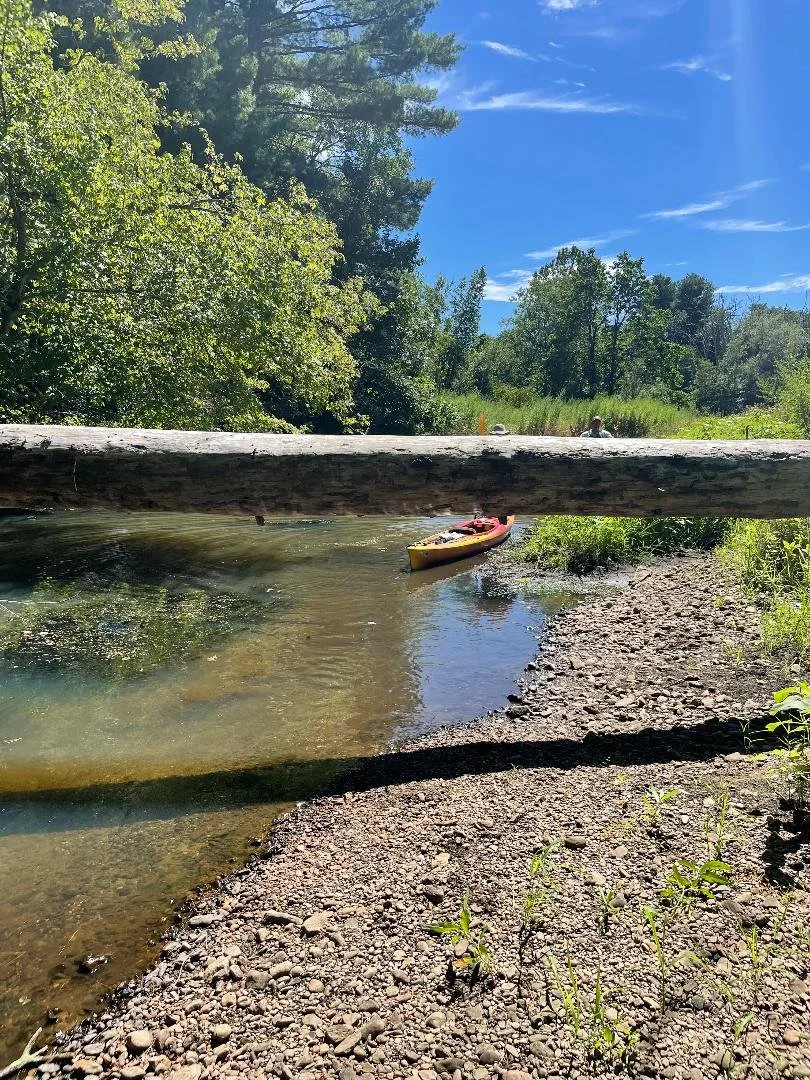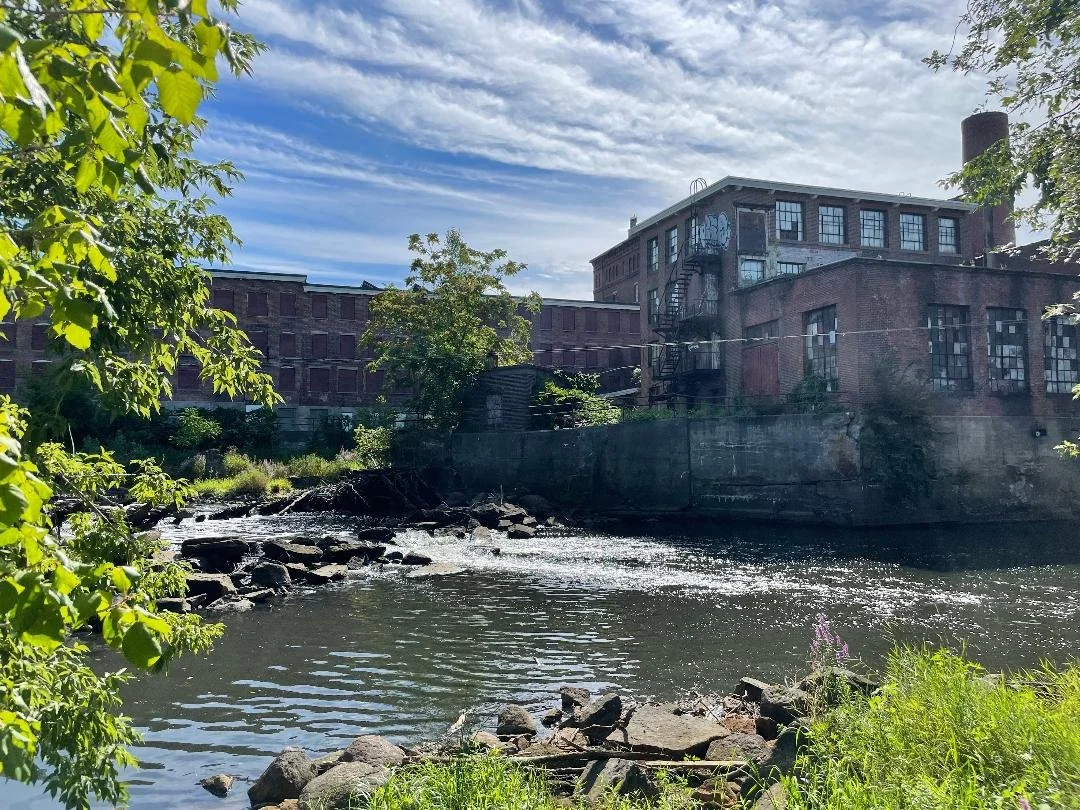Colleen Cronin: Paddling up the improving but still troubled Blackstone River
Usually the water comes up nearly to this fallen log in the Blackstone River, but due to drought conditions, passing under the tree was much easier.
— ecoRI News photo
From ecoRI News (ecori.org)
When Ed Oleksyk was growing up around the Blackstone River, he and his best friend would hike the river valley with absolutely nothing except their imaginations and ingenuity.
As they moved upriver on land, they picked up tires, pieces of plywood, metal poles, and whatever else they could find along the way — the Blackstone, called the birthplace of the American Industrial Revolution, was once more of a dumping ground than a recreational spot.
“The challenge was to ride whatever we put together” like Huck Finn and Tom Sawyer, Oleksyk said Aug. 12 as he prepared to paddle part of the river in Massachusetts from Grafton to Uxbridge in a canoe with his son Jack.
Ed and Jack Oleksyk joined a small group of travelers last week for a leg of the Blackstone River Commons Paddle, a four-day, 60-mile paddle through almost the entire historic waterway to bring attention to and advocate for the river’s preservation.
Traveling down the river from Worcester, Mass., to Narragansett Bay tells a story that’s harder to see from land, said Emily Vogler, an associate professor of landscape architecture at the Rhode Island School of Design and creator of the Blackstone River Commons, which hosted the paddle along with several other organizations.
The river’s complicated past, its recovery, and the precariousness of its future are on full display from the seat of a kayak drifting in its waters.
Because of drought conditions across Massachusetts and Rhode Island, the water table and the river are extremely low. Many parts of the river on which the group paddled Friday weren’t more than mid-shin deep.
This paddle is more of a workout for the abs than the arms, Vogler said, because when a kayak gets stuck in a shallow spot, some scooting is needed to get it floating again.
Even if the river was high, paddling in a group is about working as a team, offering advice on how to navigate safely and successfully under logs, around sharp turns, and even over land when dams and dry spots call for it.
“River right,” the elder Oleksyk called ahead of the rest of the group, telling us to move to the outer bend of the river, where it tends to be deeper. “You learn to read the river,” he advised a nervous ecoRI News reporter on her first river paddle.
Frank Cortesa, the president of Rhode Island Canoe & Kayak Association, which lent some of the boats for the paddle and provided ground support throughout, suggested looking for the “V” in the water to find the deepest point in a passage and leaning into obstacles rather than away to avoid tipping over.
While the low river conditions made paddling difficult at points, it also made it easier to float down “rapids” and reduced the dangerousness of strainers — low hanging or downed trees and branches that can catch boats and people on higher water and faster conditions, Cortesa said.
The low water level also reveals things long hidden.
Paddling past an old junkyard Vogler pointed to the exposed riverbed, layered with different types of debris, from sheets of metal to the innards of a bicycle tire.
Though some of the tires and debris along the river looked old and decayed, some of the tires and other trash in the river were new.
By end of the second day of paddling, the group had spotted more than 100 tires in and around the water. They also spotted a few bicycles, a kiddie pool, an abandoned kayak, the bed of a truck, the chassis of a car, and several traffic cones, among other smaller debris.
That kind of litter is sprinkled through the Blackstone River watershed today, but it was much worse years ago, before serious efforts to clean up the river and toughen environmental regulations began. A river cleanup is scheduled for Aug. 27, the 50-year anniversary of the massive 1972 cleanup called ZAP the Blackstone.
After the colonization and industrialization of North America and before the Clean Water Act, the Blackstone River was a place where people dumped their trash and companies left their waste.
The river fed Slater Mill, in Pawtucket, which was the first water-powered textile mill in America and where the Industrial Revolution began.
Slater was the first of many mills to crop up on the river’s banks and then leak or drain chemicals into the water; locals would say the river changed color based on the dyes being used by the fabric manufacturers each day.
Old mill and wooden dam along the Blackstone in Grafton, Mass.
— ecoRI News photo
Dams from the mills, some of which are still used today, remain scattered along the river and required the group to portage their boats over land to continue the journey. The dams not only slow down the paddlers, they also stop fish moving freely from the river into the ocean and back in lower parts of the Blackstone. But dam removal is tricky and expensive, because the structures hold back toxic sediment build-ups left behind from the industrial era, which would wreak havoc on the environments downstream.
People used to be — and sometimes still are — afraid to interact with the river.
Donna Williams, a watershed advocate for and board president of the Blackstone River Coalition, said her husband used to tell the story of someone they knew who had let their dog swim in the river in the 1970s, after which the dog got sick and died.
“That was terrible. But that was when the river was terrible,” Williams said.
Now, Williams and her husband let their dog swim in the Blackstone and he only “smells just a little worse than he did before he went in.”
The water quality has improved significantly since the ‘70s and even since the early 2000s, Williams said. She was one of the organizers of Expedition 2000, the event that the Blackstone River Commons Paddle was loosely based on. (Williams did attend the land events surrounding the paddle but didn’t hop in this time around. “I’m getting older, so I haven’t been on the river lately,” she said).
Some of the river improvements were spurred by that original paddle, Williams said, which inspired people to get involved in watershed advocacy.
Still, the signs of prior and present harm crop up frequently along the Blackstone. The crew rode over and under old sewage lines on Friday, a reminder of several serious effluent leaks early this year that caused the river to become temporarily untouchable.
A group fishing on the riverbanks warned the paddlers about the potential for spills.
But the history and the industrial tints that give the Blackstone a bad reputation can often be forgotten while floating under the green canopy of the trees along the river.
Many creatures live in or near the Blackstone, including a blue heron that swept over the heads of the paddlers to a family of ducks that spooked an ecoRI News reporter when she got a little too close to their nest, setting off lots of flapping and quacking on an otherwise quiet stretch of river.
Nature’s engineers have also made a home on the Blackstone, with beaver dams lining the river. One beaver’s tail was spotted flitting under the water during Friday’s run.
The group also purposely ran themselves aground to stop and admire an eagle perched high above the river.
“Jack and I have hiked a lot of trails,” said Ed Oleksyk, rounding a small island filled with green herons (a smaller cousin of the blue they had seen earlier), “but there’s more wildlife on the river itself.”
Many more people are beginning to appreciate the beauty of the river.
“The number of businesses that now have the word Blackstone in their name has … increased like 100-fold,” Williams said. “People were kind of embarrassed to say they lived in the Blackstone Valley, but all of this activity has just brought a tremendous sense of pride.”
The goal of the paddle was to highlight past accomplishments and the beauty of the river, while also reminding the community of what more can be done.
The paddle was partly inspired by the publication of the Blackstone River Watershed Needs Assessment last year by the Narragansett Bay Estuary Program. The report, made in collaboration with dozens of groups during the pandemic, made recommendations for how to improve the river so that it could be a better resource for people and wildlife.
In the time since the assessment came out, some progress has been made. It already prompted the creation of the Blackstone Watershed Collaborative and the hiring of Stefanie Covino as its coordinator. She participated in the full 60-mile paddle.
Some of the report’s suggestions included creating a green jobs program, developing a wetlands restoration strategy, increasing fish access, and opening access to the river equitably.
The report also outlined how to offset some of the effects of climate change, which threaten the river, its inhabitants, and the people who rely on the watershed for an important and currently scarce resource: water.
“I’ve never seen it like this,” Oleksyk said as he struggled through parts of the river that were so dry that for hundreds of feet the paddlers dragged their boats from shallow pool to shallow pool.
Covino, who decided to take a snack break before getting out of her kayak for the fifth or sixth time to drag her boat over land, noted that all the water, or lack of water, in the region was connected.
The Blackstone River is a part of a watershed covering almost 550 square miles and encompassing thousands of lakes, other rivers, ponds, reservoirs, and personal wells.
As another tributary and canal drained into the Blackstone, eventually the water rose, and the group was able to finish the paddle actually paddling in Uxbridge to join the RiverFest planned for the afternoon.
The four-day event ended with a public paddle to the Narragansett Bay that brought in 60 attendees and a celebration at Narragansett Brewery.
Colleen Cronin is a Report for America corps member who writes about environmental issues in rural Rhode Island for ecoRI News.


